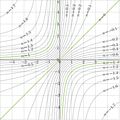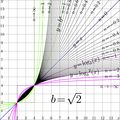Search results
Create the page "Integer" on this wiki! See also the search results found.
- ...ponentially) increases at large negative values of the argument, takes the integer value unity at zero, then decrease until its local minimum at its first zer for integer \(n>1\), where \(L_n=\,\)[[BesselJZero]]\([0,n]\) is \(n\)th zero of the [[13 KB (1,759 words) - 18:45, 30 July 2019
- ...in range of holomorphism of function, but out of holomorphism of some its integer iteration. In this case, the number \(n\) of iteration is supposed to be integer.4 KB (630 words) - 18:44, 30 July 2019
- and so on. Most of larger numbers have no single-character mames; the integer numbers are denoted using the [[positional numeral system]].5 KB (753 words) - 18:47, 30 July 2019
- In this expression, number \(n\) of iterations has no need to be integer; the [[Mandelbrot polynomial]] can be iterated arbitrary (even complex) num2 KB (229 words) - 18:44, 30 July 2019

File:Exp1mapT200.jpg even non-integer and eve nomplex iterate.(2,281 × 1,179 (1.14 MB)) - 12:37, 28 July 2013
File:Exp09mapT200.jpg For the evaluation, the non-integer iterate of exponential is expressed through [[tetration]] tet and [[arctetr(2,281 × 1,179 (1.23 MB)) - 12:28, 28 July 2013- ==Integer and non-integer \(n\)== ...here was no regular way to evaluate iteration of exponential for any non–integer number \(n\) of iteration.7 KB (1,161 words) - 18:43, 30 July 2019

File:Exp05mapT200.jpg For the evaluation, the non-integer iterate of exponential is expressed through [[tetration]] tet and [[arctetr(1,711 × 885 (872 KB)) - 12:20, 28 July 2013
File:Exp01mapT200.jpg For the evaluation, the non-integer iterate of exponential is expressed through [[tetration]] tet and [[arctetr(2,281 × 1,179 (895 KB)) - 12:04, 28 July 2013
File:Exm01mapT200.jpg For the evaluation, the non-integer iterate of exponential is expressed through [[tetration]] tet and [[arctetr(2,281 × 1,179 (834 KB)) - 12:52, 28 July 2013
File:Exm05mapT200.jpg For the evaluation, the non-integer iterate of exponential is expressed through [[tetration]] tet and [[arctetr(2,281 × 1,179 (705 KB)) - 12:54, 28 July 2013
File:Exm09mapT200.jpg For the evaluation, the non-integer iterate of exponential is expressed through [[tetration]] tet and [[arctetr(2,281 × 1,179 (560 KB)) - 12:56, 28 July 2013- In this representation, $n$ has no need to be integer; it can be real or even [[complex number]]. Several pics are loaded to [[TO10 members (0 subcategories, 9 files) - 13:04, 28 July 2013
- ...e square root above. However, for the application in evaluation of the non-integer iterate, it is convenient to keep the coefficient \(B\) positive, at least ==Non-integer iterate==13 KB (2,088 words) - 06:43, 20 July 2020

File:Frac1zt.jpg The non-integer iterates of function $T$ are evaluated using the superfunction(2,089 × 2,089 (734 KB)) - 08:36, 1 December 2018- ...s \(A\) and \(B\) can be used in order to simplify the construction of non-integer iterates of the linear fraction. One of possible choices is ...)th iteration, id est, \(T^n\) is regular at this fixed point even at non-integer values of \(n\);5 KB (830 words) - 18:44, 30 July 2019
- ...ook about evaluation of [[abelfunction]]s, [[superfunction]]s, and the non-integer [[iterate]]s of holomorphic functions. Non-integer iterates of holomorphic functions.<br>15 KB (2,166 words) - 20:33, 16 July 2023
- ...With this representation, the number \(n\) of iteration has no need to be integer. As other holomophic functions, the linear function can be iterated even co2 KB (234 words) - 18:43, 30 July 2019
- For integer \(m>0\) and \(|z|\gg 1\), function [[mori]]\((z)\) can be approximated with3 KB (456 words) - 18:44, 30 July 2019

File:IterEq2plotT.jpg For evaluation of the non-integer iteration, the plotter uses the implementation through the [[superfunction](2,922 × 2,922 (1.35 MB)) - 08:38, 1 December 2018